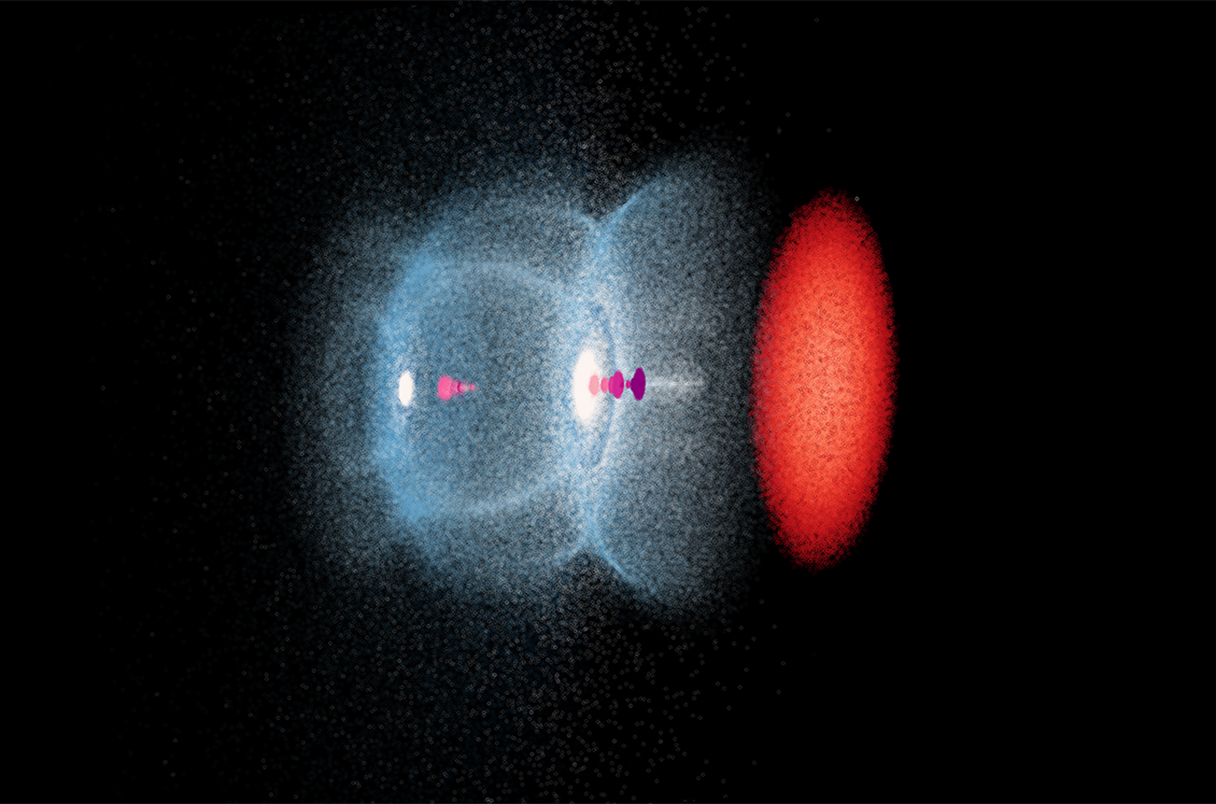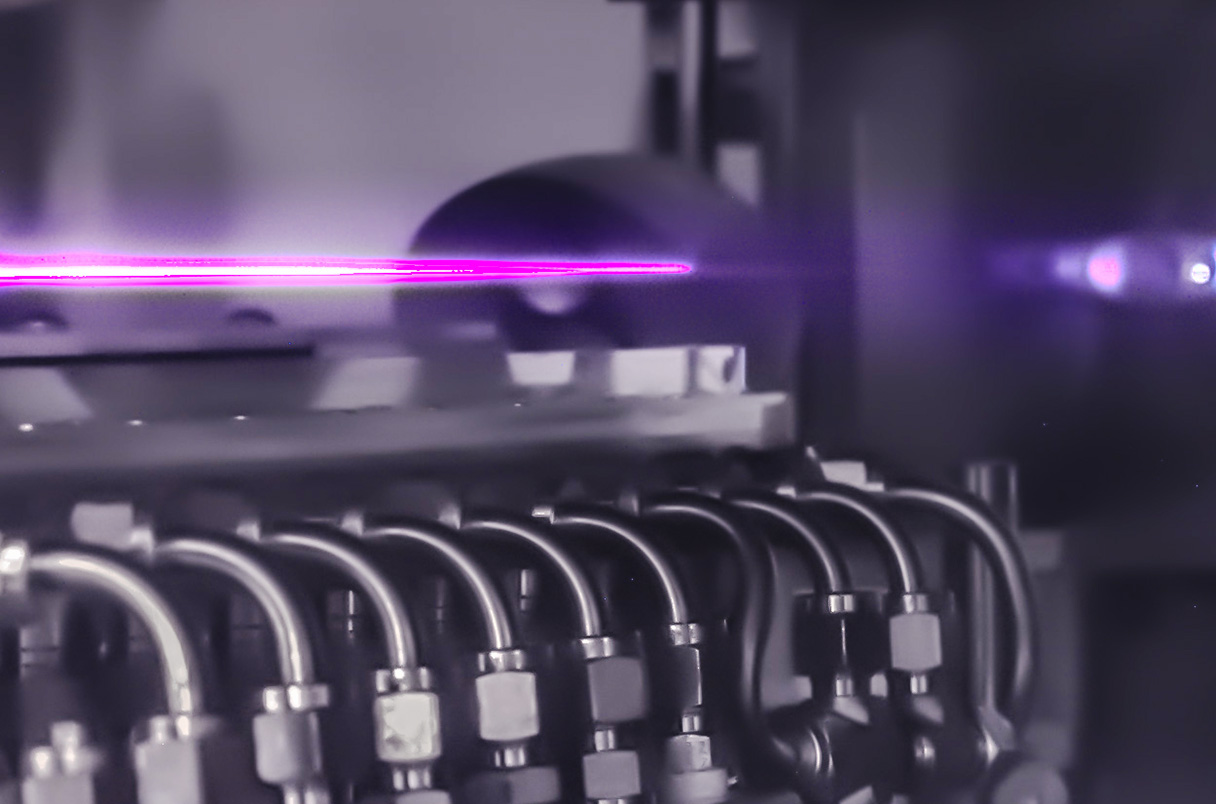
In this plasma simulation, a pulse of laser light (red) tows a wake of electrons (blue), which other electrons (magenta) surf to enormous energies.Carlo Benedetti
Little powerhouses might someday replace billion-dollar, kilometer-long behemoths at major x-ray facilities
An elegant new concept may be about to revolutionize the technology of particle acceleration, which animates huge atom smashers and x-ray sources. For decades, some physicists have strived to develop an accelerator powered by laser light that would be much smaller and cheaper than existing machines. Recent progress suggests laser plasma accelerators (LPAs) may soon realize that bright promise.
Most recently, physicists at Lawrence Berkeley National Laboratory (LBNL) used the approach to boost electrons to an energy of 9.2 giga-electron volts (GeV) over just 30 centimeters, as they reported in December 2024 in Physical Review Letters. That's more than twice the energy achieved by a new 1-kilometer-long, $1.1 billion linear accelerator (LINAC) at SLAC National Accelerator Laboratory. Although LPAs still produce relatively ragged electron beams, physicists around the world are already racing to put them to work.
“We're moving from a phase in which the plasma accelerator is the object of study to one in which it's doing something useful,” says Simon Hooker, a laser physicist at the University of Oxford. LPAs can't yet deliver the exquisitely tuned beams that physicists prize, but the much cheaper machines could find niches where beam quality isn't so crucial, says Samuel Barber, an accelerator physicist at LBNL. “You can develop a more bespoke machine.”
In a conventional accelerator, charged particles such as electrons gain energy by surfing on the electric fields in radio waves resonating within long evacuated cavities. The 80-year-old approach has a limitation: If the radio waves are too intense, they'll create sparks in the cavities. The effect limits the accelerating field and means a high-energy accelerator must be kilometers long.
Physicists can generate far stronger accelerating fields by blasting an intense pulse of laser light into low-pressure hydrogen gas. The light ionizes the gas and, like a speedboat, pushes the wispy electrons aside, leaving a region of positively charged ions. After the light passes, the electrons surge back into the positive region, creating a negatively charged wake that trails the laser pulse through the gas.
Traveling at 99.99% of light speed, that wake resembles the wave produced by fans in a sports stadium when they raise their hands in turn, notes Marlene Turner, an accelerator physicist at CERN, the European particle physics laboratory. “There's this wave of electrons that is moving forward, but it’s never the same electrons.” Yet it produces an electric field 1000 times higher than a conventional accelerator, which other electrons can surf to reach astounding energies. In 2004, multiple groups boosted electrons to 1 GeV in just a few centimeters.
But the laser pulse quickly diverges, limiting the electrons' maximum energies. To counter that spreading, Anthony Gonsalves, an accelerator physicist at LBNL; Howard Milchberg, a laser plasma physicist at the University of Maryland; and colleagues hit gas spewing from a bladelike nozzle with not one laser pulse, but two. A special mirror focused the weaker first flash into a bright line across the wide gas jet, creating a channel of low-density plasma narrower than a human hair. Acting as an optical fiber, the channel guided the second pulse, which arrived nanoseconds later.

In a hypersonic jet of hydrogen, a preliminary laser pulse (pink) forms a line of plasma that will act as an optical fiber to guide the main, more intense pulse.Alex Picksley and Anthony Gonsalves, Lawrence Berkeley National Laboratory
Others had tried guiding a pulse by using an electric current to ionize the gas in tiny glass capillaries, Turner notes. But the technique didn't as effectively guide the drive pulse, which would vaporize the glass if it hit it. In contrast, the laser-created channel is “made of entirely of plasma, so it's immune to damage,” Milchberg says. With it, researchers got the drive pulse to glide 30 centimeters, they reported last month.
The resulting energy fell just short of a record set by Manuel Hegelich, a laser plasma physicist at the University of Texas at Austin, and colleagues. In November 2023, they reported reaching 10 GeV in an unguided scheme, albeit using more laser power. But the LBNL group also managed to reduce the spread of energies yielded by previous LPAs, which picked up stray electrons in the plasma more or less randomly.
The key was to mix nitrogen into the gas. The guide laser would strip a nitrogen atom of most of its electrons, but the last two would pop loose only when the most intense part of the drive pulse arrived. “The electrons that get ionized then happen to slip right into the accelerating portion of that [plasma] bubble,” says Alexander Picksley, an accelerator physicist at LBNL. By injecting the nitrogen at only one point along the nozzle, researchers controlled how far the electrons surfed and how much energy they gained.
“All the elements of this experiment have been known for some time,” says Brigitte Cros, a plasma physicist with CNRS, the French national research agency. “But they have succeeded in putting everything together.” There's still lots of room for improvement, Milchberg says. The petawatt lasers that drive LPAs currently can only fire once a second or so, and the pulses can vary widely from one to the next, he notes. “Aside from the plasma or anything else, we need to improve the laser technology.”
Still, researchers are already thinking about a killer app: using an LPA to power a free-electron laser (FEL), a machine that generates potent x-rays by shooting a finely tuned electron beam through a long magnet that makes it slalom from side to side. The swerving electrons emit light that, in a feedback loop, separates them into tiny bunches that radiate in chorus. The result is a laser beam of x-rays, a powerful tool for studying molecules and materials
SLAC's new giant LINAC powers an FEL, but physicists could make such machines far smaller and cheaper by replacing the LINAC with an LPA. There's a global race to do just that. In 2021, physicists at the Shanghai Institute of Optics and Fine Mechanics used an LPA to drive an FEL shining at ultraviolet wavelengths. However, it produced laser light on only 10% of its shots. Last year, Barber's team at the LBNL upped that figure to 90% with its LPA. To reach useful x-ray wavelengths, however, developers will need higher energy electrons, which will likely require techniques like those combined in the new result from LBNL.
Europe is also betting big on this application. This year, as part of an effort called the European Plasma Research Accelerator with Excellence in Applications, officials will choose the site for a facility costing hundreds of millions of euros that will deploy FELs driven by LPAs. The facility aims to serve researchers and speed the development of LPAs, Cros says. “We have never been able to build a real accelerator operating all day, every day of the year, based on these techniques.”
LPAs might also work in concert with other accelerators. For example, PETRA-III, a ring-shaped accelerator at the German laboratory DESY, circulates 6-GeV electrons to generate x-rays. Currently, electrons reach that energy by first passing through a LINAC and two smaller rings. To supplement or replace all of that, Andreas Maier, a plasma accelerator physicist at DESY, and colleagues hope to use a single LPA when the facility is upgraded in 2030, using the techniques demonstrated by the LBNL group. “For us, it's a very encouraging result,” he says.
Some physicists think LPAs are already good enough to make money. Hegelich, for example, has founded a company called TAU Systems that is completing an LPA facility in Carlsbad, California, to serve customers. NASA's Jet Propulsion Laboratory has signed up to test whether electronics can stand up to the radiation environment in space, Hegelich says. The facility will also serve as a showroom, he adds. “You can go there and see the machine. And if you want one yourself, we'll build you one.”
doi: 10.1126/science.zg076m8
News from: https://www.science.org/content/article/compact-cheaper-laser-powered-particle-accelerators-get-real







